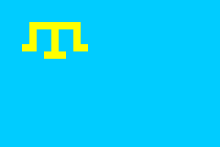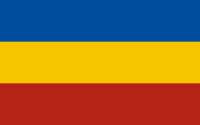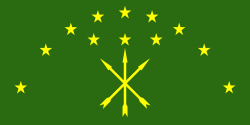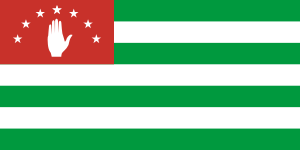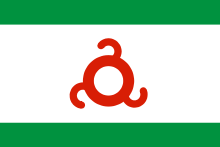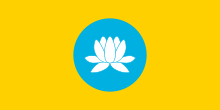Ethnic flag
An ethnic flag is a flag that symbolizes a certain ethnic group. Ethnic flags are often introduced to the ethnic community through the respective cultural or political ethnic movements.
They are popular among ethnic minorities and some ethnic majorities, especially in multiethnic countries.
The concept of an "ethnic flag" is a thoroughly modern one, derived from the idea of a national flag. Strictly speaking, the national flags of nation states are also "ethnic flags", and often so used by ethnic minorities in neighbouring states, especially in the context of irredentism (e.g. the flag of the Republic of Albania used as an "ethnic Albanian flag" by Kosovar Albanians).
The first ethnic flags (for non-existing states) were designed at the end of the 19th century, such as the Basque flag (1894) or the "Flag of Zion" used to symbolize Zionism from 1898, which became the national flag of Israel 50 years later.
Most early ethnic flags imply a connection with an unrecognized state claimed by the respective ethnicities, such as the flag of Kurdistan which originates as the flag of the Republic of Ararat (1927), or the Arab flag which originates as the flag of the Arab Revolt during World War I.
A flag of the Hispanic People was designed in 1932.
The use of national flags became popular during the 19th century along with the spread of nationalism.
The concept of using ethnic flags to symbolize ethnic groups within a multiethnic state, not necessarily connected with irredentism, became popular in the later 20th century, such as the Australian Aboriginal flag (1971), the Assyrian flag (1971), the flag of the Romani people (1971), the Berber flag (1970s), the Sami flag (1986) or the Maori flag (1990).
Designing ethnic or tribal flags has become very popular since the 1990s, especially for online use, and mostly do not have any kind of "official" status and must be judged based on de facto use.
Since the 1990s, this trend has also extended to designing ad-hoc "cultural flags" for all sorts of organizations, subcultures or ideologies not necessarily ethnic or irredentist, such as "sexuality flags", flags of micronations, etc.
Africa
North Africa and West Asia
[1]
 |
| Berbers or Amazigh people[2] (North Africa) |
|
|
|
 |
| Dinka or Jieng (Southern Sudan) |
|
|
|
|
|
 |
Assyrians (Assyria)
"The Assyrian flag was designed by George Atanos in 1968. The flag has a white background with a golden circle at the center (which represents the sun), surrounded by a four-pointed blue star (which symbolizes the land). Four triple wavy stripes start from the center and represent the three major rivers of the Assyrian territory: the Tigris, the Euphrates and the Great Zab". |
|
 |
Aramaic-Syriacs (Middle East)
"The flag chosen by the Aramaeanist faction to represent the Syriac nation is based upon a relief retrieved in Tell Halaf representing a winged sun disk. In the flag, the sun was replaced by a flame symbolizing the Holy Spirit". |
|
Horn of Africa
Eastern, Central and Western Africa
|
|
 |
| Adamawa (Bamileke National Movement) (Cameroon) |
|
|
 |
| Kongo (Republic of Congo and DRC) |
|
|
|
|
|
|
|
Southern Africa
Americas
North America
Central America and Caribbean
|
 |
| Flag of the Jatibonicu Taíno Tribal Nation of Borikén (Puerto Rico) |
|
|
|
South America
Asia
Northern, Central and Eastern Asia
Southern Asia
|
|
|
|
|
 |
| Khuzestani Arabs[24] (Khuzestan) |
|
|
|
|
|
|
|
|
|
|
|
|
|
|
|
|
Southeastern Asia
Melanesia
Australasia and Polynesia
Europe
Northern Europe
|
|
|
|
 |
| Irish (Island of Ireland) |
|
|
|
|
|
|
|
|
|
|
|
 |
| Inter-Frisian Flag of the Interfrisian Council |
|
|
|
|
|
|
|
 |
Sami people[37] (Sápmi)
"The Sami flag, inaugurated during the 13th Nordic Sami Conference in Åre, Sweden, on 15 August 1986, was created by Astrid Båhl . It is based upon a previous project by Synnøve Persenthe and upon the poem "Paiven parneh" ("Sons of the Sun"), written by Anders Fjellner, describing the Sami as sons and daughters of the sun". |
|
|
|
|
|
|
|
|
 |
| Võros (Võrumaa) older version |
|
 |
| Võros (Võrumaa) since February 2013 |
|
|
Central Europe
Southwestern Europe
Southeastern Europe
Eastern Europe, Caucasia and Anatolia
|
|
|
|
|
|
|
|
|
|
|
|
|
|
|
|
|
|
|
|
|
|
|
|
|
|
|
 |
Romani people[37] (Europe and Brazil)
“The Romani flag (O Styago le Romengo), approved during the first World Romani Congress, was created by the General Union of the Roma of Romania (Uniunea Generala a Romilor din Romania), in 1933. The flag contains a red Chakra, in the centre, representing the migratory heritage of the Romani people”. |
|
 |
| Yiddish originally from Central and Eastern Europe |
|
See also
Notes
- ↑ This is the flag of the Arab Revolt.
- ↑ To be precise, the Druze are a religious and cultural group rather than a distinct ethnic group.
- ↑ See also the concept of Sindhudesh.
- ↑ This is just one of several flags used by groups that make up this macro-group.
- ↑ Akha are considered part of the Hani by the government of People's Republic of China, though this is a subject of some dispute among the Akha themselves.
Citations
- ↑ Smith, Whitney. "Flag of Israel". Encyclopædia Britannica. Retrieved 14 July 2014.
- ↑ "Berbers". Flags of the World. April 24, 2009. Retrieved April 24, 2010.
- ↑ "History of the flag". Flags of the World. June 26, 2006. Retrieved April 25, 2010. The Flag of Somalia, created by Mohammed Awale Liban, was designed to represent pan-Somali territories.
- ↑ "Amhara (Ethiopia)". Flags of the World. September 13, 2003. Retrieved October 25, 2010.
- ↑ "Afar (Ethiopia)". Flags of the World. September 13, 2003. Retrieved October 25, 2010.
- ↑ "Harari (Ethiopia)". Flags of the World. June 24, 2006. Retrieved October 25, 2010.
- ↑ "Oromo traditional colours". Flags of the World. May 29, 2003. Retrieved June 30, 2010.
- ↑ "Tigray (Ethiopia)". Flags of the World. April 29, 2004. Retrieved October 25, 2010.
- ↑ "Bakonjo People". Flags of the World. July 12, 2008. Retrieved April 24, 2010.
- ↑ "Ashanti People". Flags of the World. November 4, 2006. Retrieved April 24, 2010.
- ↑ Minahan, James (2002). Encyclopedia of the Stateless Nations: S-Z. Greenwood Publishing Group. p. 762. ISBN 0-313-32384-4. Retrieved June 3, 2010.
- ↑ "Afrikaner". Unrepresented Nations and Peoples Organization. Retrieved June 30, 2010.
- ↑ 13.0 13.1 Znamierowski, p236
- ↑ Miller, Richard. "From History to Destiny". The Mulatto People. Archived from the original on February 15, 2001. Retrieved April 22, 2010.
- ↑ "Native Peoples of Colombia". Flags of the World. July 3, 2009. Retrieved July 9, 2010. According to FOTW, this flag represent primarily the Guambiano or Misak tribe, but it also represents Native peoples of Southwestern Colombia.
- ↑ "Inca (Quechua/Aymara) people". Flags of the World. June 16, 2007. Retrieved April 23, 2010. The term Wiphala is refrered to flags of Inca origin, today used by the Native Andean peoples to represent themselves.
- ↑ "Mapuche". Unrepresented Nations and Peoples Organization. Retrieved July 9, 2010.
- ↑ "Tuva". Unrepresented Nations and Peoples Organization. Retrieved June 15, 2010.
- ↑ "Hainan". Flags of the World. February 10, 2007. Retrieved June 18, 2010.
- ↑ Poisson, Barbara Aoki (2002). The Ainu of Japan. Minneapolis: Lerner Publications. ISBN 978-0-8225-4176-9.
- ↑ "Iraqi Turkmen". Unrepresented Nations and Peoples Organization. Retrieved June 18, 2010.
- ↑ "Zazaistan". Flags of the World. April 24, 2009. Retrieved June 19, 2010. FOTW shows this banner as the alleged flag of Zazas. Moreover, according to an article published in Le Monde, signed by Lucien Philippe, the site states that the flag has been used in several ethnic riots until 1980. Finally FOTW shows other three flags that are not supported by any source definable as reliable.
- ↑ Unrepresented Nations and Peoples Organization
- ↑ "Ahwazi". Unrepresented Nations and Peoples Organization. Retrieved July 1, 2010.
- ↑ "Flag of the Baloch people". Flags of the World. April 25, 2008. Retrieved March 27, 2010. There are different variants of the flag used by Baloch independentists to represent their people.
- ↑ "Hunza". Flags of the World. June 7, 2008. Retrieved June 19, 2010.
- ↑ "Ladakh". Flags of the World. February 14, 2007. Retrieved June 16, 2010.
- ↑ "Chagossians at UNO". chagos.org. January 30, 2003. Retrieved June 20, 2010.
- ↑ "Akha People". Flags of the World. August 9, 2008. Retrieved June 23, 2010.
- ↑ "Khmer Krom". Unrepresented Nations and Peoples Organization. Retrieved June 23, 2010.
- ↑ "Free Aceh Movement". Flags of the World. December 13, 2008. Retrieved June 23, 2010.
- ↑ 32.0 32.1 Znamierowski, p238
- ↑ "Proclamation under the Flags Act 1953" (PDF). ComLaw — Commonwealth of Australia Law. January 25, 2008. Retrieved April 20, 2010.
- ↑ "Harold Thomas – Creator of the Aboriginal Flag". ABC Online. May 23, 2002. Retrieved April 20, 2010.
- ↑ "Denise Davis: Moriori. Te Ara — the Encyclopedia of New Zealand". Solomon, Māui. Retrieved June 9, 2006.
- ↑ "'Original' flag raises debate". Honolulu Advertiser. February 12, 2001. Retrieved April 17, 2010.
- ↑ 37.0 37.1 37.2 37.3 37.4 Znamierowski, p237
- ↑ "Mouvement Normand". Flags of the World. June 14, 2003. Retrieved June 9, 2010.
- ↑ "Svenska Brevmärken 1922" (in Swedish). Svenska Centralarkivet. Retrieved April 5, 2010. The flag of Finland-Swedes appears on some stamps issued by the Swedish People's Party in 1922.
- ↑ "Meänkieliset ottavat käyttöön Meän maan lipun" (in Finnish). Kaleva Online. July 13, 2007. Retrieved June 9, 2010.
- ↑ "East Karelia". Flags of the World. September 12, 2009. Retrieved June 8, 2010.
- ↑ "Lyydi people". Flags of the World. September 12, 2009. Retrieved June 8, 2010.
- ↑ "Vepsia". Flags of the World. April 14, 2007. Retrieved June 8, 2010.
- ↑ "Inkeri". Unrepresented Nations and Peoples Organization. Retrieved June 9, 2010.
- ↑ "Ingria". Flags of the World. April 14, 2007. Retrieved June 9, 2010.
- ↑ Minahan, James (2002). Encyclopedia of the Stateless Nations: S-Z. Greenwood Publishing Group. p. 2018. ISBN 0-313-32384-4. Retrieved June 9, 2010.
- ↑ "In pictures: The Seto people — Anthem and flag". BBC News Online. Retrieved June 9, 2010.
- ↑ "Livonian People". Flags of the World. February 18, 2006. Retrieved June 9, 2010.
- ↑ "German-speaking Community (Belgium)". Flags of the World. January 17, 2009. Retrieved June 10, 2010.
- ↑ "The Red Lion is the Civil Ensign of the Gran Duchy of Luxemburg. In 2006, the banner was proposed as the new national flag. On 6 July 2007, the Government of Luxembourg refused the proposal, but, at the same time, established the equal status of this flag and the Official Tricolor. Instead, in the Belgian province of Luxemburg, the Red Lion has not an official status, but it (with a different shade of blue) is of common use: it is used even by the Provincial Council on public buildings or in official occurrences". http://www.province.luxembourg.be/provlux/provlux_fr_profils_province_lux/l-institution-provinciale/blason-palais-logo-drapeau-et-chant-provincial/drapeau/drapeau.htm http://www.gouvernement.lu/dossiers/viepol/drapeau/index.html
- ↑ "Estatuto de Autonomía de Canarias" (PDF) (in Spanish). Gobierno de Canarias. Retrieved June 13, 2010. The flag, which was made official by the Organic Law 10/82 on 16 August 1982, is based upon the original design attributed to Carmen Sarmiento, Jesús Cantero and Arturo Cantero and adopted by the Canarias Libre movement in 1961.
- ↑ "Estatuto de Autonomía de Aragón" (PDF) (in Spanish). Boletín Oficial
de Aragón. April 23, 2007. Retrieved April 10, 2010. The Statute defines Aragonese People as an "historical nationality".
- ↑ "Occitania". Flags of the World. December 26, 2009. Retrieved June 11, 2010.
- ↑ 54.0 54.1 "Legge 15 Dicembre 1999, n. 482 - Norme in materia di tutela delle minoranze linguistiche storiche" (in Italian). Gazzetta Ufficiale della Repubblica Italiana. December 20, 1999. Retrieved April 5, 2010.
- ↑ http://www.skdprosvjeta.com/news.php?id=66
- ↑ Danforth, Loring (1995), The Macedonian Conflict, Princeton, New Jersey: Princeton University Press, p. 164, ISBN 978-0-691-04356-2
- ↑ "Symbols of the Bosniaks of Sandžak". Flags of the World. March 18–19, 2005. Retrieved April 17, 2010.
- ↑ Vickers, Miranda (2007), The Cham Issue — Where to Now?, ARAG Balkan Series, Swindon, United Kingdom: Defence Academy of the United Kingdom, p. 21, ISBN 978-1-905962-01-3
- ↑ "Rusyn Symbols". Academy of Rusyn Culture in the Slovak Republic. Retrieved June 12, 2010.
- ↑ "Crimean Tatars". Unrepresented Nations and Peoples Organization. Retrieved June 12, 2010.
- ↑ "Erzian ethnic flag". Flags of the World. February 2, 2002. Retrieved June 12, 2010.
- ↑ "Circassia". Unrepresented Nations and Peoples Organization. Retrieved June 12, 2010.
- ↑ "Abkhazia". Unrepresented Nations and Peoples Organization. Retrieved June 12, 2010.
- ↑ "Flags of daghestanian ethnic groups". Flags of the World. January 8, 2003. Retrieved June 13, 2010.
- ↑ История Лезгинского народа (in Russian). Lezgini Kultuuriühing Eestis. Retrieved June 13, 2010.
- ↑ "Meshtekistan". Flags of the World. January 30, 2010. Retrieved June 12, 2010.
- ↑ "Ajaria". Flags of the World. April 24, 2010. Retrieved June 12, 2010.
Bibliography and references
External links
Northern Africa
Western Africa
Middle Africa
Southern Asia
Notes and citations for external links
- ↑ A flag of Hausa people was proposed in 1966. It is a banner with five horizontal stripes: red, yellow, indigo blue, green, and khaki beige.
- ↑ "Asia: flags of the ethnic minorities and stateless nations". Encyclopædia Heraldica. Retrieved May 4, 2010.
- ↑ Goodrick-Clarke, Nicholas, Hitler's Priestess: Savitri Devi, the Hindu-Aryan Myth, and Neo-Nazism (New York University Press, 1998, hardcover: ISBN 0-8147-3110-4, paperback: ISBN 0-8147-3111-2 Plate 3, between Pages 80 and 81, shows a picture of the Hindi ethnic flag (“Pan Hindu National Flag”)
|
|---|
| | Related concepts | |
|---|
| | Ethnology | |
|---|
| | Groups by region | |
|---|
| | |
|---|
| | Multiethnic society | |
|---|
| | |
|---|
|
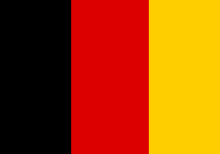

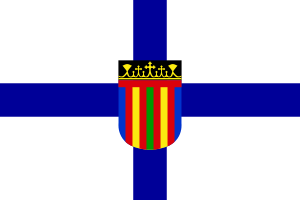










.svg.png)










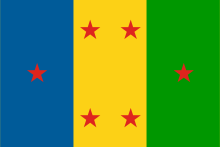




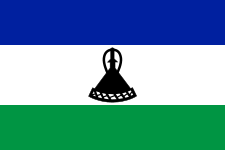
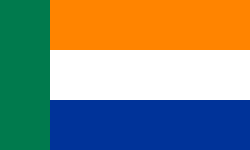
















































.svg.png)


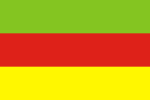





.svg.png)














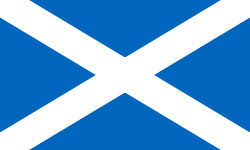


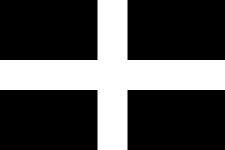

.svg.png)














.svg.png)










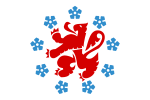

.svg.png)





.svg.png)


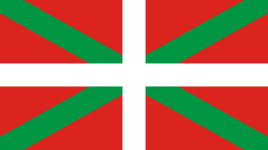


.svg.png)

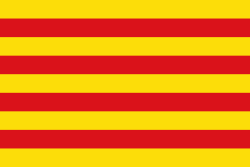
.svg.png)





.svg.png)



.svg.png)


.svg.png)


